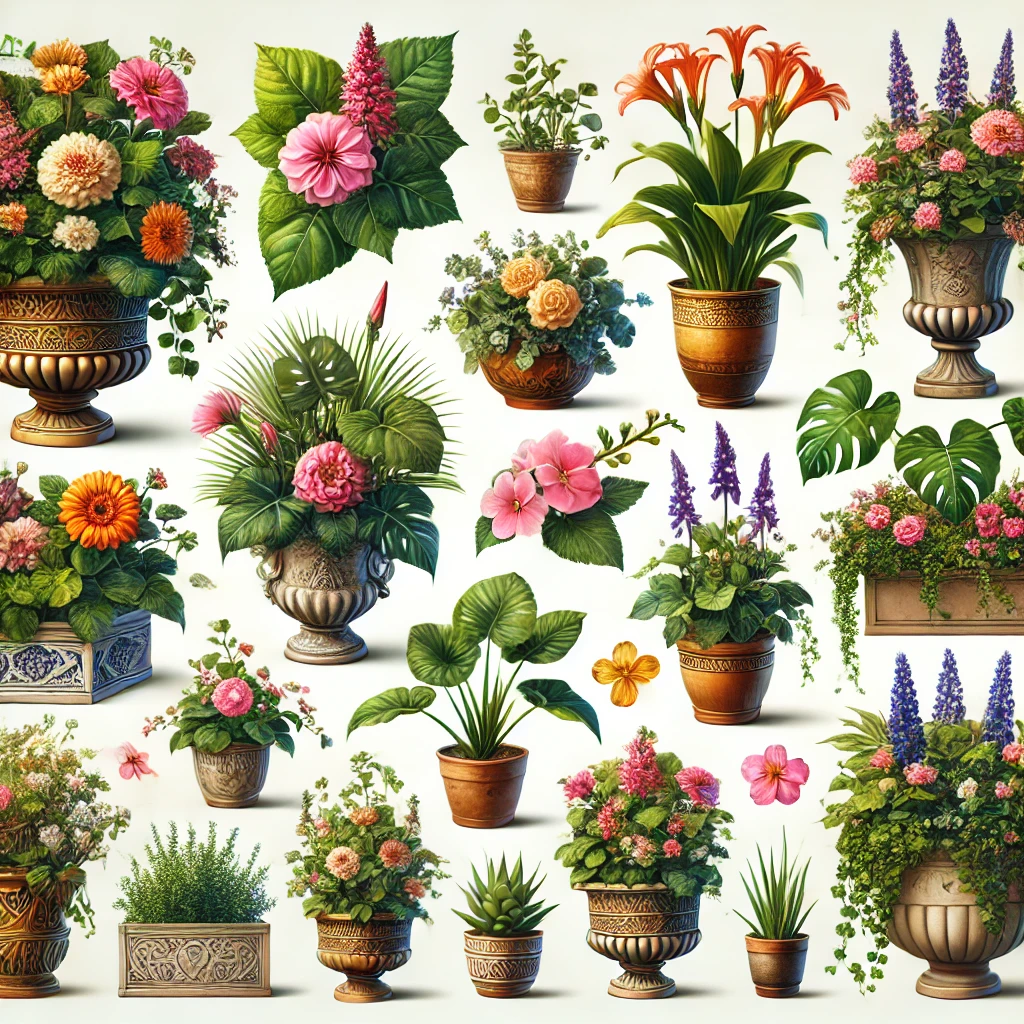Decorative Plants: Beauty, Function, and the Art of Nature
Decorative Plants: Beauty, Function, and the Art of Nature
Decorative plants have long held a cherished place in our homes, gardens, and public spaces. These living green ornaments do more than just add color and texture to their surroundings; they bring life, tranquility, and a sense of nature’s touch into our daily lives. Whether used indoors to brighten a room or outdoors to enhance the landscape, decorative plants serve as an important tool in both interior and exterior design.
In this discussion, we explore the significance of decorative plants, their benefits, types, and how they contribute to the aesthetic value of various spaces.
1. The Role of Decorative Plants in Interior Design
In interior design, decorative plants are used to create atmosphere, add personality to a space, and soften the harsh lines of furniture and architecture. Plants can transform a sterile room into a warm, inviting environment. The vibrant greenery of a houseplant contrasts beautifully with modern minimalistic designs or sleek furniture, while larger ornamental plants, such as palm trees or monstera, can be used as statement pieces to create focal points in a living room or hallway.
Decorative plants, particularly indoor varieties, can be tailored to suit various décor styles. For instance, succulents in stylish pots complement a contemporary or Scandinavian look, while hanging ferns or ivy are more suitable for rustic or bohemian themes. With such diversity, plants can integrate seamlessly into any style, offering a versatile and eco-friendly option to elevate the space.
2. Types of Decorative Plants
There are numerous types of decorative plants, each with unique characteristics that make them ideal for different settings. Below are some of the most popular and widely loved categories of ornamental plants:
- Flowering Plants: Plants that bloom and produce vibrant flowers bring an undeniable charm to any space. These plants can be grown both indoors and outdoors, depending on the climate. Examples include orchids, roses, lilies, and geraniums. Flowering plants can fill a room with fragrance, color, and joy, adding a lively touch to home décor.
- Foliage Plants: Foliage plants, or plants primarily valued for their leaves, are often used for their rich textures, various shades of green, and unique patterns. Examples include the snake plant (Sansevieria), pothos, and rubber plants. These plants are incredibly easy to care for, making them ideal for beginners, and they continue to be popular choices in home and office décor.
- Succulents: Known for their ability to store water in their thick leaves, succulents are low-maintenance and drought-resistant. They come in an array of shapes, sizes, and colors, making them suitable for a variety of decorative arrangements. Cacti, jade plants, and aloe vera are all types of succulents that add an elegant, minimalist touch to home décor.
- Vines and Climbers: Vines like ivy, pothos, and philodendrons can bring a natural, cascading effect to indoor spaces. When grown on trellises or allowed to trail from hanging pots, these plants create an effortlessly charming aesthetic. They can also help create a sense of fullness in areas that would otherwise feel empty or too rigid.
- Tropical Plants: Tropical plants such as palm trees, monstera, and birds of paradise thrive in warm, humid environments. These plants are perfect for adding an exotic flair to both indoor and outdoor spaces. Their bold foliage and vibrant blooms lend a touch of luxury, making them an excellent choice for more lavish or expansive settings.
- Herbs and Small Edible Plants: Edible plants like basil, thyme, rosemary, and lavender are not only decorative but also practical. Planted in pots, they can be placed on windowsills, patios, or kitchen counters, offering fresh ingredients for cooking as well as a pleasant aromatic presence. These plants also create a sense of sustainability, giving homeowners a small-scale garden that contributes to both aesthetics and functionality.
3. Benefits of Having Decorative Plants
Apart from their obvious aesthetic value, decorative plants offer a host of other benefits that enhance the living experience. Here are some reasons why having decorative plants around is a good idea:
- Improved Air Quality: Many indoor plants, particularly foliage types, help purify the air by absorbing carbon dioxide and releasing oxygen. Some plants, such as peace lilies and spider plants, can also filter out harmful chemicals like benzene, formaldehyde, and trichloroethylene, improving the air quality in your home.
- Stress Reduction: Studies have shown that having plants in indoor environments can help reduce stress levels. The act of caring for plants, combined with their calming presence, can lead to improved emotional well-being. Whether you’re tending to your houseplants or simply enjoying their beauty, the green color and natural forms evoke relaxation and calmness.
- Enhance Concentration and Creativity: The presence of decorative plants in work or study spaces can boost cognitive function. Plants have been shown to improve concentration, focus, and creativity. Adding plants to your workspace helps to create an environment that encourages productivity while keeping you grounded in nature.
- Humidity Regulation: Plants can also regulate humidity levels by releasing moisture into the air through a process called transpiration. This helps prevent the air from becoming too dry, which can be especially beneficial in areas with heating or air conditioning systems.
- Natural Decoration: Unlike synthetic décor elements, plants are organic, living additions to your space. Their growth patterns change over time, offering an ever-evolving display that cannot be replicated with static décor. This makes them a dynamic part of home styling, giving the space an organic, living essence.
4. Caring for Decorative Plants
Though decorative plants can be easy to care for, they do require attention and specific conditions to thrive. It’s important to select plants that are suited to your home environment. For example, plants with higher light requirements should be placed in areas with ample natural sunlight, while low-light plants should be placed in more shaded spaces. Proper watering schedules are essential to prevent overwatering or underwatering, and the right pots with drainage holes ensure healthy root growth.
Fertilization is another key component of plant care. Many plants benefit from occasional feeding, especially during their growing season. Regular pruning and cleaning also help maintain a tidy and healthy appearance. Additionally, repotting is necessary as plants grow larger to provide them with fresh soil and more space for their roots.
5. Decorative Plants in Outdoor Spaces
While decorative plants are commonly found indoors, they also play an important role in outdoor landscaping. From small potted plants on balconies to expansive flower beds and manicured hedges, plants are an integral part of exterior décor. A well-designed garden can complement the architectural style of a house, providing harmony between the indoors and outdoors.
In outdoor spaces, plants such as flowers, shrubs, and trees can be used to create mood and function. Climbing plants like wisteria and jasmine can add a romantic touch to trellises and fences, while ornamental grasses can soften the edges of garden pathways. Larger plants like topiary bushes and ornamental trees create visual balance and grandeur. Plants can even be used to create living walls or screens for privacy.
6. Conclusion
Decorative plants are more than just beautiful elements of décor; they are living expressions of nature that contribute to the overall ambiance and functionality of any space. Whether it’s for their aesthetic value, air-purifying qualities, or emotional benefits, incorporating plants into your home or garden is a simple way to enrich your environment. With so many types and varieties to choose from, there’s a perfect decorative plant for every space, allowing you to create a vibrant, welcoming atmosphere that connects you to the natural world.
The growing trend of incorporating plants into interior and exterior design reflects a broader cultural shift toward embracing nature, sustainability, and the well-being of both individuals and the environment. By surrounding ourselves with plants, we invite nature’s beauty and balance into our lives, fostering not only physical and emotional health but also a deeper appreciation for the world around us.

